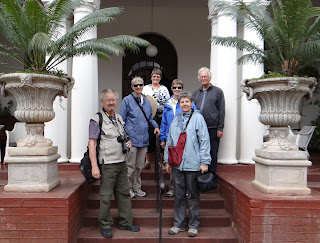 We could almost hear the adolescent rhino whining, "C'mon, Mom, get up. Let's goooo!"
We could almost hear the adolescent rhino whining, "C'mon, Mom, get up. Let's goooo!"But her mom was having none of it. Mom and baby white rhino were content to continue napping.
We were in the 3000 square kilometer Matobo National Park outside Bulawayo in southern Zimbabwe, with one of the largest populations of white and black rhinoceros. The afternoon was cloudy and cool, weather that encourages wildlife to be out in the open rather than in the trees, seeking respite from the heat.
Mom didn't even open one eye, so the young rhino backed up to her, trying to push her up. Tonnage-wise, the youngster was at a disadvantage. Mom didn't budge.

Next idea: lick Mom's behind. Big butt, little tongue. Not very effective.
Next move: bite Mom's butt. That got her attention.

Unfortunately, this little family is probably doomed. Our guide told us that, because of increasing poaching for the soaring black market in Asia, where ground rhinocerous horn is believed to cure hangovers, the animals may be extinct in 10 years. Even if conservationists remove the horns, these rhinos may be killed since poachers don't want to waste time tracking a rhino that will yield no horns.








